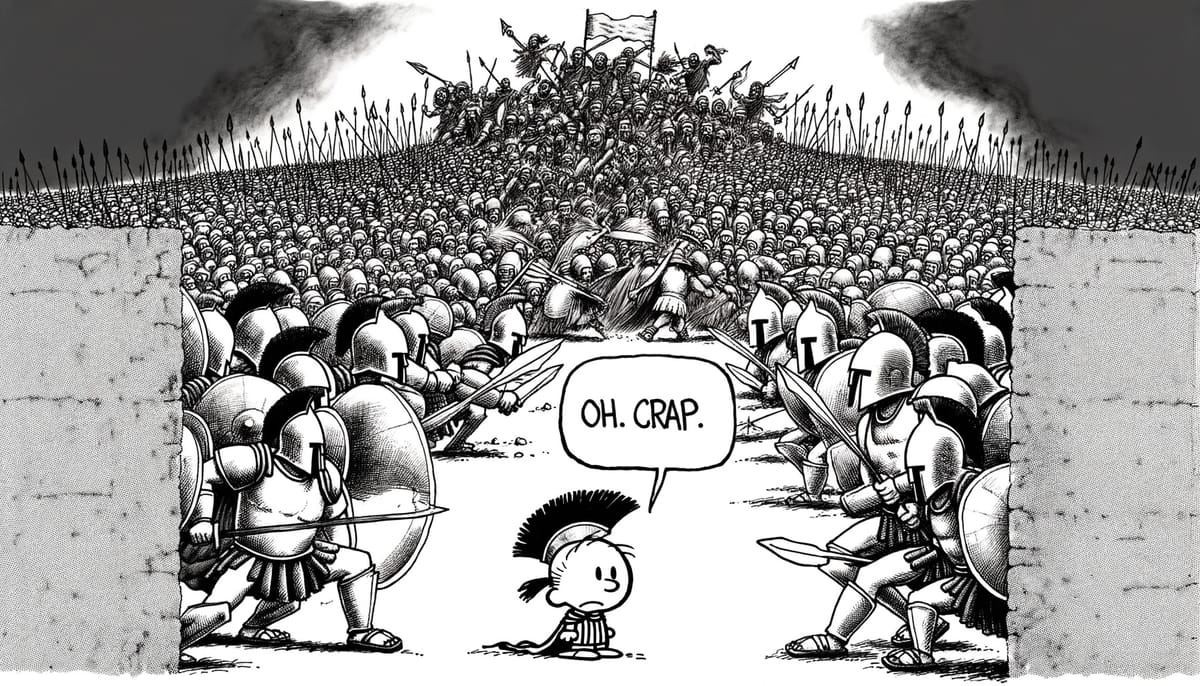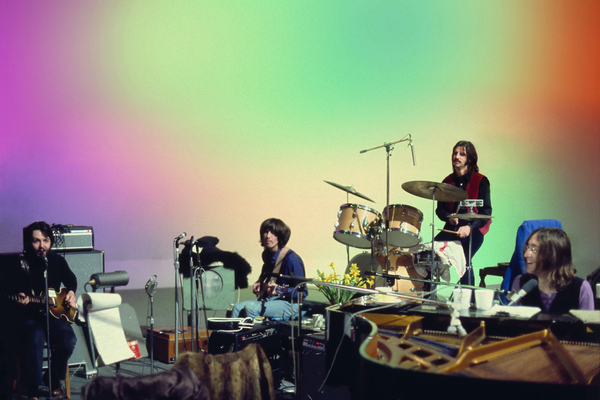Think Small For Big Growth

🎵 🎧 🎸
Music has always been my foremost passion. As an elementary student, I was drawn to the arts (might’ve had something to with my natural ability to draw and my natural disdain for numbers). For a period of time I played the saxophone, experimented with my brother’s violin, toyed with my brother’s drum pad (there’s a pattern developing) and eventually settled on the guitar. Today I play the guitar pretty well, and I’m “good enough” on bass and drums.
It all started at thirteen when this song came on in the car. My dad, brother and I were going through the drive-thru at a local Wendy’s. Instantly, my brother and I begged him to turn off what, we thought, was lame-o music. My dad simply said, “just wait.” And then… that solo. Robert Plant’s desperate howl. I was in. I started guitar lessons and never looked back.
(Fun fact: the first song I learned was “Glycerine” by Bush. Judge me, I don’t care. It slayed at my backyard concerts in the summer of ’95.)
Warp ahead to 2001, and I’ve got my first iPod. (Sidebar — those commercials were my first subconscious love affair with marketing. I was transfixed when they came on. The Daft Punk version was my fave.) That little machine was glorious. 1,000 songs in my pocket?!? For someone who spent high school and college sucking up heaps of bandwidth on Napster and later Limewire, this mighty little machine was a godsend. Now I could carry my heavily curated, eclectic taste with me wherever I chose to roam.
Big impact can be felt from small things.
(Ask the dinosaurs — the meteor that likely wiped them out was about 6–9 miles around. In the grand scheme of the universe, that’s puny… ok, I know we’re getting off-track…)🦖 💥
In the glorious old days of social media (you know, circa 2015), brands only had eyes for the big fish—celebrities and mega-influencers with follower counts in the millions. Oh, wait: yeah, that’s still most brands today. And those companies are missing out. Big time.
If you want to catch the attention of consumers, motivate action and not just burn through your marketing budget faster than a Kardashian marriage, you need to think small. Small means big ROI. Small means more relevance, which ultimately drives richer reach. Going small means employing a strategy to ‘ambush the algorithms.’

During social media’s Jurassic period (let’s say pre-2018), algorithms were simpler, posts were chronological, and life was easy. Brands could get massive reach just by posting at the right time. Fast-forward to today, and algorithms on platforms like Instagram, Facebook, and TikTok are more complex and secretive than the recipe for Coca-Cola. Brands get near-zilch on organic reach. When the product is free, users are the product. That means social media companies must monetize through ad revenues. They monetize through ad revenues by showcasing huge, heavily engaged audiences. It’s not rocket science, even if the algorithms seem that way.
Early on, it was easy to monetize based upon simple signals like follower count and engagement. However, over time social media companies began to shift because they saw diminishing returns from keeping users engaged with the accounts in their network. Growth was needed, and it would come from a shift to focus less on connections and more on content.
Quite simply, social media has evolved from social graphs to interest graphs.
Then: Algorithms used to prioritize content based on simple engagement metrics like followers, likes, and comments. If something gained traction and was relevant to a user’s network, it was seen.
Now: Algorithms prioritize content based on a cocktail of factors, with priority on engagement and relevance. The algorithm indexes more emphatically that the content will be found interesting by a user than by which account the content is published, throttling reach for accounts that would reduce monetization opportunities for the platform. In plain English, this means your brand’s post about the latest product line is more likely to be seen if it's coming from an influencer your target audience interacts with regularly, rather than from your corporate account. We’re witnessing a seismic shift known as the creation generation, and there are some important lessons for brands to learn, and fast:
1. You are not in total control of your brand.
2. Relevance matters (a lot) more than reach.
3. Growth comes from getting beyond your core.
Public data repeatedly shows that micro and nano influencers have higher engagement rates compared to their macro counterparts. According to a study by Markedly, influencers with fewer than 1,000 followers have an average engagement rate of 8%, while those with 10 million+ followers have a rate of just 1.6%. That’s massive. We’re talking about a 400% higher rate of return. So next week when your CMO says you need to find a “face” for the brand, tell him to add an “s” to the end of that.
Plus, let's face it: not every brand can afford to throw a million dollars at a Kardashian to hawk their product for a millisecond on Instagram. Micro influencers, however, are more affordable and often work with brands in exchange for free products or modest fees. This makes them a viable option for small to medium enterprises (SMEs) looking to maximize their marketing ROI. Sure, a micro influencer doesn't have a million followers. Quality over quantity, folks. Micro influencers typically operate within niche markets, meaning their followers are more likely to be genuinely interested in the products they promote. Which in turn positively juices the algorithm. Would you rather have your product seen by 1 million uninterested people, or 10,000 highly engaged potential customers?
People trust people, not faceless corporations. A survey by Edelman found that 63% of consumers trust influencers' opinions of products much more than what brands say about themselves. Micro and nano influencers tend to have closer relationships with their followers, making their recommendations seem more genuine and less like a sales pitch. Their lack of polish works in their favor. Micro influencer content frequently feels more authentic and less like a commercial, which resonates better with today's savvy consumers, who can smell a sales pitch from a mile away.
(This is where I have to say — you do still need to disclose a partnership according to FTC guidelines. Don’t get cute. Trust me.)
An army of millions overpowers even the strongest, smaller fighting force eventually. Look at the Greek tragedy of Thermopylae. Sure, 300 Greeks held a massive invading army at bay for awhile… and then eventually they were all killed. You’re begging to be disrupted if you don’t focus on spreading autonomy and equity for your brand across relevant niches.

Celsius is a brand doing this really well right now. Instead of building a roster of big-name ambassadors, they’re gobbling up market share in the highly competitive energy drink market by focusing on distribution. The obvious example is their product — it’s almost impossible to go into a grocery, convenience store, bodega or big-box online retailer without seeing Celsius displayed. Clearly, they understand that you sell from the shelf, not the stockroom.
What Celsius also understands is that distribution matters online, and they’re focused on cultivating an army of content creators — from fans to employees and on to influencers. They’re drilling into niches that connect to their “Live Fit” message, and adjacent niches that tie into cultural trends their would-be customers care about. All of this activity feeds a flywheel that drives more and more Celsius content front and center in feeds. That awareness leads to more search for Celsius, and — clearly with a 4X growth in market share since 2019 — more sales. They’re successfully ambushing algorithms.
Pulling this off requires a few things. For one, scalability. If you’re a marketing leader, and you think you’re pulling this off with a lone social media manager, think again. You need a well-defined team to take on the algorithms. I break it down into three parts:
COMMUNITY: what stories are percolating with people?
CREATORS: who’s telling the stories?
CONTENT: where and how are the stories being told?
OPERATION: ALGO AMBUSH requires that these three functions operate in sync, with strong leadership in place for each. These areas require independent focus to align strategy, develop tactical plans, drill into analysis and ultimately unite for growth. It’s an investment, predicated upon a strong foundation that includes clear brand identity and positioning, as well as a flywheel design to drive decision-making.
Moreover, it requires a shift in storytelling. Eschew long, singular campaigns for shorter, trendier vignettes. Prioritize relevance over reach. Move at the speed of culture. The days of decentralization are upon us. The niches rule our feeds. It’s time to embrace it.
Go forth, and heed the words of Gavin Rossdale from his band’s biggest hit:
Don't let the days go by
Could've been easier on you
I couldn't change though I wanted to
⚡️🤘🏻⚡️




